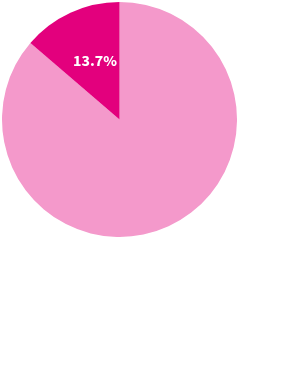How many US children receive free or reduced-price school lunch?
Nearly three-quarters of all school lunches are served free or at a reduced price.
In 2024, 21.4 million students received subsidized lunches through the National School Lunch Program (NSLP) — 72.5% of all public-school lunches were served free or at a discount. NSLP subsidies are available to public school students as well as students at nonprofit private schools.
During the COVID-19 pandemic, school closures led to a drop in NSLP participation, from 29.6 million kids in 2019 to 11.0 million in 2021; fewer open schools meant fewer kids needing lunch. A pandemic waiver allowed all students who were physically attending school to receive free meals, and 98.9% of all 2021 school lunches were at least partially subsidized. The free and reduced-price school lunch program is now resettling after that aberration.
More students are receiving free lunch than before the pandemic.
Average number of students receiving school-served lunches, FY 1969–FY 2024
Which students qualify for free or reduced-price lunch?
The Department of Agriculture (USDA) administers the NSLP at the federal level, and nearly 100,000 public and nonprofit private schools participate in the program. Students K through 12 can take part, with eligibility based on federal poverty thresholds.
A student from a household with an income at or below 130% of the poverty income threshold qualifies for free lunch, and a student from a household earning between 130% and 185% of the threshold qualifies for reduced-price lunch.
These NSLP eligibility levels will remain in effect for the 2025–2026 school year.

How many kids are eligible for free and reduced-price lunches?
The National Center for Education Statistics reports that 53.3% of US public school students were eligible for free or reduced-price lunch in the 2022–2023 school year, more than in any year since the pandemic.
This figure varied by over 80 percentage points across states, from 18.7% of students in Montana public schools to 99.7% in Mississippi. In three states — Mississippi, Nevada (81.5%), and New Mexico (75.2%) — more than three-quarters of students qualified.
99.7% of all Mississippi public schoolers were eligible for subsidized lunches.
Percentage of students eligible for free and reduced-price school lunches, 2022–2023 school year
How did the pandemic impact the availability of free school lunches?
As a part of the government’s pandemic response, the USDA made school breakfast and lunch free for all NSLP-covered students, no matter their family’s income. As a result, 98.8% of school lunches were free in FY 2021 as were 95.5% in FY 2022, after which the program ended.
In response to the continued demand for free school lunches, nine states have passed legislation to extend free school meals to all students regardless of family income. These include:
- California
- Colorado
- Maine
- Massachusetts
- Michigan
- Minnesota
- New Mexico
- New York
- Vermont
The proposed Universal School Meals Program Act of 2021 would permanently allow all K-12 public school students to receive free school meals but has yet to pass in either chamber of Congress.
Where have participation numbers rebounded the most since COVID-19?
All 50 states had more students participating in the program in 2024 than in 2020, the first year of the pandemic downturn. Nationally, there were 33% more participating students in 2024 than 2020; some individual states have outpaced that growth rate and others haven’t.
The states with the most growth in NSLP participation since FY 2020 include Vermont (+85%), Maine (+82%), and Colorado (+79%) — each of which has expanded eligibility with state legislation. Those with the most modest growth have been Tennessee (+1%), Utah (+4%), and South Dakota (+7%).
Subsidized lunch enrollment has increased in all states since 2020.
Change in the number of students receiving free or reduced school lunches, FY 2020–FY 2024
Read more about American students and get the latest data by signing up for our newsletter.
Keep exploring
Page sources
Department of Agriculture
National School Lunch Program
Census Bureau
Survey of Income and Program Participation Data

